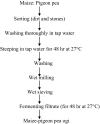Nutritional composition and antinutritional properties of maize ogi cofermented with pigeon pea
- PMID: 29564110
- PMCID: PMC5849929
- DOI: 10.1002/fsn3.571
Nutritional composition and antinutritional properties of maize ogi cofermented with pigeon pea
Abstract
Maize was cofermented with pigeon pea for ogi production and evaluated for nutritional (proximate composition, minerals, vitamins, and amino acid profile analyses) and antinutritional (phytate, tannin, and trypsin inhibitor activity analyses) qualities. White maize and pigeon pea were mixed at ratios of 90:10, 80:20, 70:30, 60:40, and 50:50, respectively, with 100:0 serving as the control. Mixtures were cofermented for 96 hr at 27°C ± 2°C and nutritional, mineral, and antinutritional qualities were analyzed using analysis of variance. Results of proximate analysis showed that the values were significantly difference at p ≤ .05. Maize cofermented with pigeon pea at a ratio of 60:40 had the highest protein (22.79 mg/100 g), fat (19.27 mg/100 g), ash (2.98 mg/100 g), crude fiber (0.73 mg/100 g), and lowest moisture (1.98 mg/100 g) content, and was significantly (p ≤ .05) different from the other ratios. Of all the mixtures analyzed, 60:40 was significantly (p ≤ .05) different and had the highest Vitamin B1, B2, and B3 contents. Amino acid profile results showed that maize cofermented with pigeon pea at a ratio of 60:40 showed the highest contents of lysine (93.95 mg/g), tryptophan (20.38 mg/g), isoleucine (54.78 mg/g), phenylalanine (86.23 mg/g), leucine (109.55 mg/g), and valine (68.29 mg/g), respectively, and was significantly (p ≤ .05) different from the other ratios. Results of antinutritional analysis showed low phytate, tannin, and trypsin inhibitor values in maize cofermented with pigeon pea at a ratio of 60:40 when compared with other ratios. The cofermented maize-pigeon pea product 60:40 had high amino acid profile than the others.
Keywords: antinutritional; maize; nutritional; ogi; pigeon pea.
Figures
Similar articles
-
Microbiological assessment of maize ogi cofermented with pigeon pea.Food Sci Nutr. 2018 May 9;6(5):1238-1253. doi: 10.1002/fsn3.651. eCollection 2018 Jul. Food Sci Nutr. 2018. PMID: 30065825 Free PMC article.
-
Nutritional composition of gluten-free flour from blend of fonio (Digitaria iburua) and pigeon pea (Cajanus cajan) and its suitability for breakfast food.J Food Sci Technol. 2020 Oct;57(10):3611-3620. doi: 10.1007/s13197-020-04393-7. Epub 2020 May 26. J Food Sci Technol. 2020. PMID: 32903969 Free PMC article.
-
Physicochemical and sensory quality of breakfast cereals produced from flour blends of maize and pigeon pea.Heliyon. 2025 Feb 10;11(4):e42612. doi: 10.1016/j.heliyon.2025.e42612. eCollection 2025 Feb 28. Heliyon. 2025. PMID: 40028574 Free PMC article.
-
Effect of isolation techniques on the characteristics of pigeon pea (Cajanus cajan) protein isolates.Food Sci Nutr. 2017 Nov 12;6(1):146-152. doi: 10.1002/fsn3.539. eCollection 2018 Jan. Food Sci Nutr. 2017. PMID: 29387372 Free PMC article.
-
The Dietary Use of Pigeon Pea for Human and Animal Diets.ScientificWorldJournal. 2022 Jan 24;2022:4873008. doi: 10.1155/2022/4873008. eCollection 2022. ScientificWorldJournal. 2022. PMID: 35110974 Free PMC article. Review.
Cited by
-
Influence of adding edible termite flour to Ogi powder: its chemical and phytochemical composition.Front Nutr. 2024 Jul 5;11:1403660. doi: 10.3389/fnut.2024.1403660. eCollection 2024. Front Nutr. 2024. PMID: 39036497 Free PMC article.
-
Nutritional Properties of Ogi Powder and Sensory Perception of Ogi Porridge Made From Synthetic Provitamin: A Maize Genotype.Front Nutr. 2021 Jun 25;8:685004. doi: 10.3389/fnut.2021.685004. eCollection 2021. Front Nutr. 2021. PMID: 34249994 Free PMC article.
-
African fermented foods: overview, emerging benefits, and novel approaches to microbiome profiling.NPJ Sci Food. 2022 Feb 18;6(1):15. doi: 10.1038/s41538-022-00130-w. NPJ Sci Food. 2022. PMID: 35181677 Free PMC article. Review.
-
Nutritional Evaluation of Enhanced Unsieved Ogi Paste with Garlic and Ginger.Prev Nutr Food Sci. 2019 Sep;24(3):348-356. doi: 10.3746/pnf.2019.24.3.348. Epub 2019 Sep 30. Prev Nutr Food Sci. 2019. PMID: 31608262 Free PMC article.
-
Nutritional compositions and bioactive compounds of "Shameta", A traditional home made fermented porridge provided exclusively to lactating mothers in the western part of Ethiopia.Heliyon. 2022 Feb 17;8(2):e08990. doi: 10.1016/j.heliyon.2022.e08990. eCollection 2022 Feb. Heliyon. 2022. PMID: 35243103 Free PMC article.
References
-
- Adeleke, A. O. , & Oyewole, O. B. (2010). Production of ogi from germinated sorghum supplemented with soybeans. Africa Journal of Biotechnology, 9(42), 7114–7121.
-
- Adeyemi, I. A. , & Soluade, E. O. (1993). Development and quality evaluation of pawpaw‐ogi. Plant Foods Human Nutrition, 44(3) , 213–220. https://doi.org/10.1007/BF01088315 - DOI - PubMed
-
- Adeyeye, E. I. , & Fagbohun, E. D. (2005). Proximate, mineral and phytate profile of some selected spices found in Nigeria. Pakistan Journal of Scientific and Industrial Research, 48(1), 14.
-
- Adeyeye, E. I. , & Faleye, F. J. (2004). Mineral components for health from animal sources. Pakistan Journal of Scientific and Industrial Research, 47, 471–477.
-
- Agunbiade, J. A. , Bello, R. A. , & Adeyemi, O. A. (2002). Performance characteristics of weaner rabbits on cassava peel‐based balanced diets. Nigerian Journal for Animal Production, 29(1), 171–175.
LinkOut - more resources
Full Text Sources
Other Literature Sources
Research Materials
Miscellaneous


